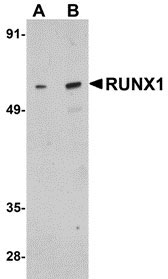RUNX1 Antibody
- 产品详情
- 实验流程
- 背景知识
Application
| WB, E |
|---|---|
| Primary Accession | Q01196 |
| Other Accession | AAI36381, 223459612 |
| Reactivity | Human, Mouse, Rat |
| Host | Rabbit |
| Clonality | Polyclonal |
| Isotype | IgG |
| Calculated MW | 48737 Da |
| Concentration (mg/ml) | 1 mg/mL |
| Conjugate | Unconjugated |
| Application Notes | RUNX1 antibody can be used for detection of RUNX1 by Western blot at 1 - 2 µg/mL. |
| Gene ID | 861 |
|---|---|
| Other Names | Runt-related transcription factor 1, Acute myeloid leukemia 1 protein, Core-binding factor subunit alpha-2, CBF-alpha-2, Oncogene AML-1, Polyomavirus enhancer-binding protein 2 alpha B subunit, PEA2-alpha B, PEBP2-alpha B, SL3-3 enhancer factor 1 alpha B subunit, SL3/AKV core-binding factor alpha B subunit, RUNX1, AML1, CBFA2 |
| Target/Specificity | RUNX1; |
| Reconstitution & Storage | RUNX1 antibody can be stored at 4℃ for three months and -20℃, stable for up to one year. As with all antibodies care should be taken to avoid repeated freeze thaw cycles. Antibodies should not be exposed to prolonged high temperatures. |
| Precautions | RUNX1 Antibody is for research use only and not for use in diagnostic or therapeutic procedures. |
| Name | RUNX1 |
|---|---|
| Synonyms | AML1, CBFA2 |
| Function | Forms the heterodimeric complex core-binding factor (CBF) with CBFB. RUNX members modulate the transcription of their target genes through recognizing the core consensus binding sequence 5'- TGTGGT-3', or very rarely, 5'-TGCGGT-3', within their regulatory regions via their runt domain, while CBFB is a non-DNA-binding regulatory subunit that allosterically enhances the sequence-specific DNA-binding capacity of RUNX. The heterodimers bind to the core site of a number of enhancers and promoters, including murine leukemia virus, polyomavirus enhancer, T-cell receptor enhancers, LCK, IL3 and GM-CSF promoters (Probable). Essential for the development of normal hematopoiesis (PubMed:17431401). Acts synergistically with ELF4 to transactivate the IL-3 promoter and with ELF2 to transactivate the BLK promoter (PubMed:10207087, PubMed:14970218). Inhibits KAT6B-dependent transcriptional activation (By similarity). Involved in lineage commitment of immature T cell precursors. CBF complexes repress ZBTB7B transcription factor during cytotoxic (CD8+) T cell development. They bind to RUNX-binding sequence within the ZBTB7B locus acting as transcriptional silencer and allowing for cytotoxic T cell differentiation. CBF complexes binding to the transcriptional silencer is essential for recruitment of nuclear protein complexes that catalyze epigenetic modifications to establish epigenetic ZBTB7B silencing (By similarity). Controls the anergy and suppressive function of regulatory T-cells (Treg) by associating with FOXP3. Activates the expression of IL2 and IFNG and down-regulates the expression of TNFRSF18, IL2RA and CTLA4, in conventional T-cells (PubMed:17377532). Positively regulates the expression of RORC in T-helper 17 cells (By similarity). |
| Cellular Location | Nucleus. |
| Tissue Location | Expressed in all tissues examined except brain and heart. Highest levels in thymus, bone marrow and peripheral blood |
For Research Use Only. Not For Use In Diagnostic Procedures.
Provided below are standard protocols that you may find useful for product applications.
BACKGROUND
RUNX1 Antibody: RUNX1 is one of three mammalian RUNX genes that control multiple aspects of embryonic development and are responsible for the pathogenesis of many human diseases. RUNX1 plays major roles in the development of nociceptive sensory neurons in addition to hematopoietic stem cells (HSC) with the exception of the erythroid lineage. During development, Notch signals mediate RUNX1 induction with SCL/GATA/Ets factors, and Wnt signals potentially cooperate with RUNX1 to facilitate adult HSC expansion via cooperative induction of cyclin D, cdk4, and other cell cycle regulators. In turn, RUNX1 regulates cell cycle transitions dependent on functional/physical interactions with other proteins such as HDAC1 and -3, mSin3A, p300, SMAD proteins, and LEF/TCF.
REFERENCES
Lund AH and van Lohuizen M. RUNX: a trilogy of cancer genes. Cancer Cell2002; 1:213-5.
Inoue K, Shiga T, and Ito Y. Runx transcription factors in neuronal development. Neur. Dev.2008; 3:20.
North TE, Stacy T, Matheny CJ, et al. Runx1 is expressed in adult mouse hematopoietic stem cells and differentiating myeloid and lymphoid cells, but not in maturing erythroid cells. Stem Cells2004; 22:158-68.
Lee TI, Jenner RG, Boyer LA. Control of developmental regulators by Polycomb in human embryonic stem cells. Cell2006; 125:301-13.
终于等到您。ABCEPTA(百远生物)抗体产品。
点击下方“我要评价 ”按钮提交您的反馈信息,您的反馈和评价是我们最宝贵的财富之一,
我们将在1-3个工作日内处理您的反馈信息。
如有疑问,联系:0512-88856768 tech-china@abcepta.com.























 癌症的基本特征包括细胞增殖、血管生成、迁移、凋亡逃避机制和细胞永生等。找到癌症发生过程中这些通路的关键标记物和对应的抗体用于检测至关重要。
癌症的基本特征包括细胞增殖、血管生成、迁移、凋亡逃避机制和细胞永生等。找到癌症发生过程中这些通路的关键标记物和对应的抗体用于检测至关重要。 为您推荐一个泛素化位点预测神器——泛素化分析工具,可以为您的蛋白的泛素化位点作出预测和评分。
为您推荐一个泛素化位点预测神器——泛素化分析工具,可以为您的蛋白的泛素化位点作出预测和评分。 细胞自噬受体图形绘图工具为你的蛋白的细胞受体结合位点作出预测和评分,识别结合到自噬通路中的蛋白是非常重要的,便于让我们理解自噬在正常生理、病理过程中的作用,如发育、细胞分化、神经退化性疾病、压力条件下、感染和癌症。
细胞自噬受体图形绘图工具为你的蛋白的细胞受体结合位点作出预测和评分,识别结合到自噬通路中的蛋白是非常重要的,便于让我们理解自噬在正常生理、病理过程中的作用,如发育、细胞分化、神经退化性疾病、压力条件下、感染和癌症。






